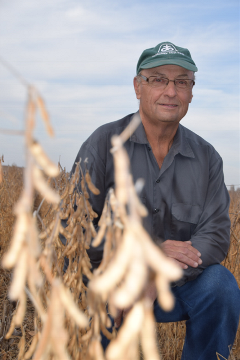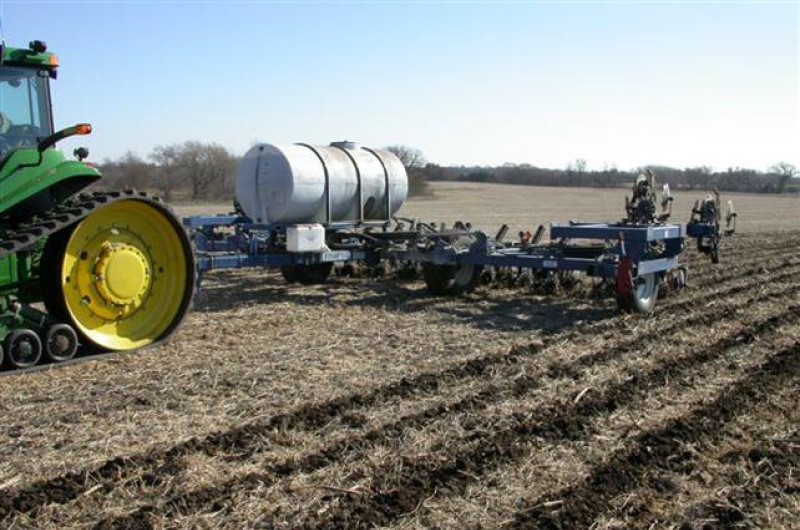 Wayne Fredericks
Wayne Fredericks
Take a summer drive through this flat farm country of Mitchell County in north central Iowa and, to the unsuspecting traveler, the area farms look alike. Miles upon miles of tall corn or soybeans bordered by old fence rows and road ditches. But, if one takes the time to get out of the car and wander through one of Wayne Fredericks’ fields, an immediate difference becomes obvious.
One barely sees traces of Iowa’s famous black loamy soil in between the rows of soybeans. Instead, the soil is covered with dead plants, or what’s referred to as crop residue. However, it’s not dead plants from this year’s crop. Those dead plants come from last year’s corn crop as well as the dead residue from cereal rye, a grass increasingly used in this part of the country for what is known as cover crops.
A cover crop is one of the main practices for improving soil health. As the name implies, it provides cover for what otherwise would be bare soil during times of the year when there isn’t an active crop growing, such as winter and early spring. Keeping a plant growing during those times protects the soil from wind and water erosion, as well as temperature extremes. Additionally, the added root structure improves soil stability, water infiltration and soil biology.
Some might call Fredericks a cover crop evangelist, although he prefers the term “educator.” He spends a portion of his time giving presentations to other farmers about topics such as cover crops, and two other practices he uses and strongly endorses, no-till and strip-till farming.
Contrary to the age-old practice of tilling the entire field before planting, which is now known to be highly destructive to the soil’s structure, biology and its ability to hold precious water and carbon, no-till farming utilizes a specially designed planter that allows the seeds to be deposited right through last year’s crop residue. Strip-till farming also utilizes a special planter that only tills a narrow strip for the seeded area while leaving the rest of the soil undisturbed. Both methods are critical to protecting the soil.
Fredericks enjoys sharing the lessons he has learned from his family farm. His megaphone also includes his positions as a board member for the American Soybean Association and the Iowa Soybean Association.
“I like to think I’m helping move the needle,” Fredericks told me by phone one cold day in February. The “needle” partly refers to the larger regenerative agriculture and soil health movement that is sweeping across farm country.
This movement, built around the concept of improving soil health through various principles and practices, has the additional benefit of greatly improving the profitability of the farm. For conservation organizations like the Izaak Walton League of America, the “needle” also means cleaner rivers and lakes, better fish and wildlife habitat and an overall improved quality of life for flora and fauna.
Regenerative Agriculture
Farming to conserve natural resources is nothing new. But regenerative agriculture takes it to an entirely new level, where Mother Nature is considered a partner in lieu of something that must be subdued. Still, Fredericks didn’t come into it with intent.
“I tell people that I’m the accidental conservationist,” he remarks. He says he was a conventional farmer who fall-plowed corn and soybeans ground until 1992, when livestock chores and an early hard freeze prevented him from turning one clod of soil. Later that winter, he read about a young Minnesota farmer who was planting soybeans directly into no-till corn stubble with a newly designed John Deere drill planter. After checking with his local implement dealer, he agreed to let them bring out a similar rig for demonstration.
“Man, that just worked slicker’n darn, you know,” Fredericks says. “So we drilled everything, all 470 acres. We hadn’t done anything [tilling] to it.” He says the new beans looked good and the yields were just as good, so he never went back to tilling his soil.
“Had it not been for an early freeze that year, I don’t know if I’d ever gotten involved in this conservation thing,” Fredericks says. “Mother Nature did me a favor. The savings on equipment, time, and fuel, it was so obvious.”
Fredericks isn’t shy about voicing his frustration about why more farmers don’t adopt similar practices. He recognizes that declining yields is one of a farmer’s biggest fears. But he says that using only yields as a measure of success is the wrong approach. Rather, it’s the profits afterwards that are most important.
“We’ve been able to document huge savings over the years and our yields still remain competitive,” he says. “That’s the kind of message we’re trying to get across.”
Fredericks is also passionate about water quality. He discusses the Gulf of Mexico dead zone in his presentations, and he continually measures nitrate levels coming out of his farm’s drainage tile before it drops into Rock Creek, a small tributary to Iowa’s Cedar River.
 Strip-till planting in last year's no-till soybean and cover crop residue.
Strip-till planting in last year's no-till soybean and cover crop residue.
Cleaner Water as a Byproduct
Through the years he’s perfected the use of cereal rye as a cover crop, to where his data routinely shows a reduction of nitrates by 70 percent. That cover crop is producing drainage water that carries a lower nitrate level than what is in the creek.
“I’m putting tile water into the creek and making it cleaner!” he proudly proclaims. “That’s why I get so excited by what cover crops do.”
Fredericks was the first farmer within the Rock Creek Watershed to put in a bioreactor, a specially designed catch basin. It utilizes wood chips and other organic matter to catch drainage water and remove the nitrates before the tile dumps into an adjacent creek. He soon realized, however, that using cover crops were a much better tool since they work to keep the nitrogen in the field where it’s utilized by the plants versus seeing it run off.
“Bioreactors are a tremendous tool for treating water for downstream users, but it doesn’t benefit the farm one bit,” he says. “I’m not ready to put in another one because I think they’re just another thing to maintain. Besides, you don’t need it if you’ve got cover crops.”
Fredericks also takes the old saying, “We all live downstream” seriously. His presentations often touch on the historic 2008 floods in Cedar Rapids, Iowa, located on the Cedar River, one of the Mississippi River’s biggest Iowa tributaries.
“I show that flooding in my presentation, with a photo of flooded Rock Creek behind my house,” he says. “That water five days later was in Cedar Rapids, Iowa. You start connecting to the fact that what I do on my farm can affect a lot of people downstream.”
“Where do we go with the liability for the water coming off of our land?” he asks. “Right now, that doesn’t get looked at.”
Therefore, Fredericks is adamant about increasing water infiltration, referring to the amount of water that penetrates deep into the soil where it becomes available for plants throughout the growing season, versus running off and down the river. One general rule often cited by some soil scientists says that a one percent increase of soil organic matter can result in extra storage capacity of approximately 20,000 gallons of water per acre. A standard metric measures the amount of rainfall that penetrates the soil in inches-per-hour. When asked if he collects such data, Fredericks chuckles.
“We don’t have to,” he says. “We see it. I just love to hop in my pickup after we get a quick three-quarters of an inch of rain and drive around the neighborhood. You can pick out those conventional farms. It’s day and night. You can see water running down the roads and ditches, and then you see another one where it looks really nice.”
Fredericks encourages his farming audience to find their own motivation for using conservation practices. Whether it’s one’s soil, water issues, wildlife or simply improving the bottom line, it doesn’t really matter to him.
“For me it’s pride in knowing I’ve done everything I can to address soil health, cleaner water, habitat for wildlife… all of it,” he says. “We’ve got a great big picture window where we can watch the deer and the pheasants. And we’ve got more monarchs now too!”
“Hell, I’m going to be 69 this month and we’re still looking at what we can do different,” he says. “I’ve never farmed the same two years in my life. And if some of my passion would rub off on a few farmers when I make my presentations, I guess that would make my day.”
A 70 PERCENT REDUCTION IN NITRATES
High levels of nitrates in Iowa’s rivers are a huge problem, largely stemming from agriculture runoff and excess applications of nitrogen fertilizer. When nitrogen isn’t taken up by plant growth, it can be carried away in the form of nitrates. By measuring for nitrates in water exiting his farm’s drainage tile into a nearby creek, Fredericks has shown that continual use of cover crops such as cereal rye grass, which provides plant growth and root structure throughout much of the year, can dramatically reduce measurable nitrates.
- 2015 Tile* water samples averaged—13.98 mg/l (no cover crops)
- 2016 Tile water samples averaged—4.17 mg/l (with cover crops)
- Federal standards for nitrates in drinking water—10 mg/l
*A farm tile uses a buried pipe to convey water into a ditch or creek.